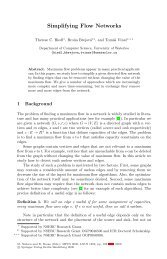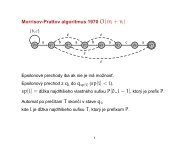1 The Junction Tree Algorithm (Hugin algorithm) Chapter 16(17 ...
1 The Junction Tree Algorithm (Hugin algorithm) Chapter 16(17 ...
1 The Junction Tree Algorithm (Hugin algorithm) Chapter 16(17 ...
Create successful ePaper yourself
Turn your PDF publications into a flip-book with our unique Google optimized e-Paper software.
not triangulated<br />
triangulated<br />
<strong>The</strong>orem 2. A graph has a junction tree if and only if it is triangulated.<br />
We will prove ⇐ direction only, needed to prove correctness of the <strong>algorithm</strong>.<br />
Observation: Let A ⊆ V and let G[A] is subgraph induced by A, i.e. G[A] = (A,E ∩ A 2 ). If G<br />
is triangulated, then so is G[A].<br />
Lemma 2. Let G = (V,E) be a non-complete triangulated graph with at least three nodes. <strong>The</strong>n<br />
there exists a decomposition of V into non-empty disjoint sets A, B, and S such that S is complete<br />
and it separates A and B (i.e. every path from a vertex in A to a vertex in B goes through a vertex<br />
in S).<br />
Proof. If graph not connected, choose S as a single vertex and each of A and B contain some<br />
connected components.<br />
Choose a pair of non-adjacent nodes α and β. Let S be the minimal set of nodes such that any<br />
path from α to β passes through S. Let A be the set of nodes reachable from α when S is removed,<br />
B be the set of nodes reachable from β when S is removed and let X = V \ (A ∪ B ∪ S). Note<br />
that X may be empty. Clearly A ∪ X and B are separated by S. We only need to prove that S is<br />
complete.<br />
Let C and D be non-adjacent nodes in S. Both C and D have neighbours in both A and B,<br />
because S is minimal. Neighbour of C in A and neighbour of D in A are connected in A (at least<br />
through α). Take the shortest path from C to D that uses only vertices in A as internal vertices.<br />
Similarly take the shortest path from C to D that uses only vertices in B as internal vertices. Joins<br />
these paths – you get cycle of length at least 4. It must have a chord. This chord cannot be edge<br />
(C,D), because they are non-adjacent. <strong>The</strong> cord cannot be entirely in A because the path was<br />
chosen as shortest. It cannot be from a vertex in A to C or D for the same reason. By symmetry the<br />
same holds for B. It cannot go from A to B because then S is not a separator. Contradiction.<br />
Definition 2. A node is simplicial if all of its neighbours are connected.<br />
Lemma 3. Every triangulated graph that contains at least two nodes has at least two simplicial<br />
nodes. If the graph is not complete, then these nodes can be chosen to be non-adjacent.<br />
Proof. We use induction on the number of vertices. As a base case the proof holds for the graph<br />
with two vertices.<br />
Consider triangulated graph with N+1 vertices. If complete, every node is simplicial. Otherwise<br />
we decompose the graph into A, B and S as in the previous lemma. Subgraph G[A ∪ S] is<br />
triangulated and by induction hypothesis it has at least two simplicial nodes. If G[A ∪ S] is not<br />
complete, choose these two nodes non-adjacent. <strong>The</strong>n at least one of them is in A (S is complete).<br />
7









